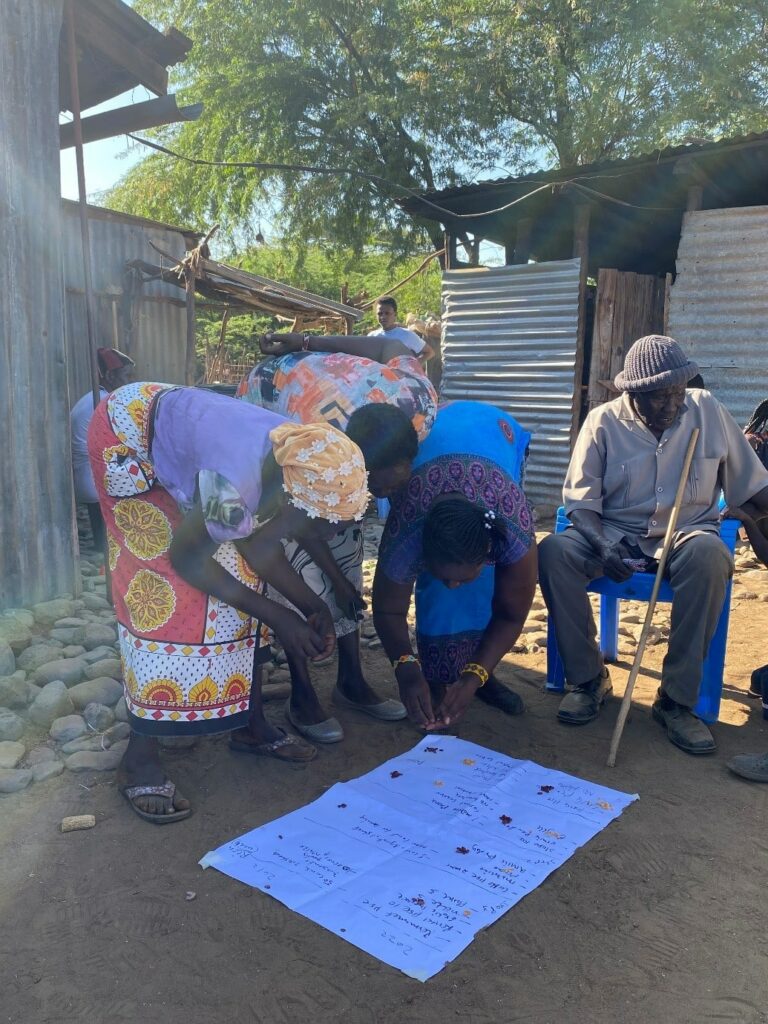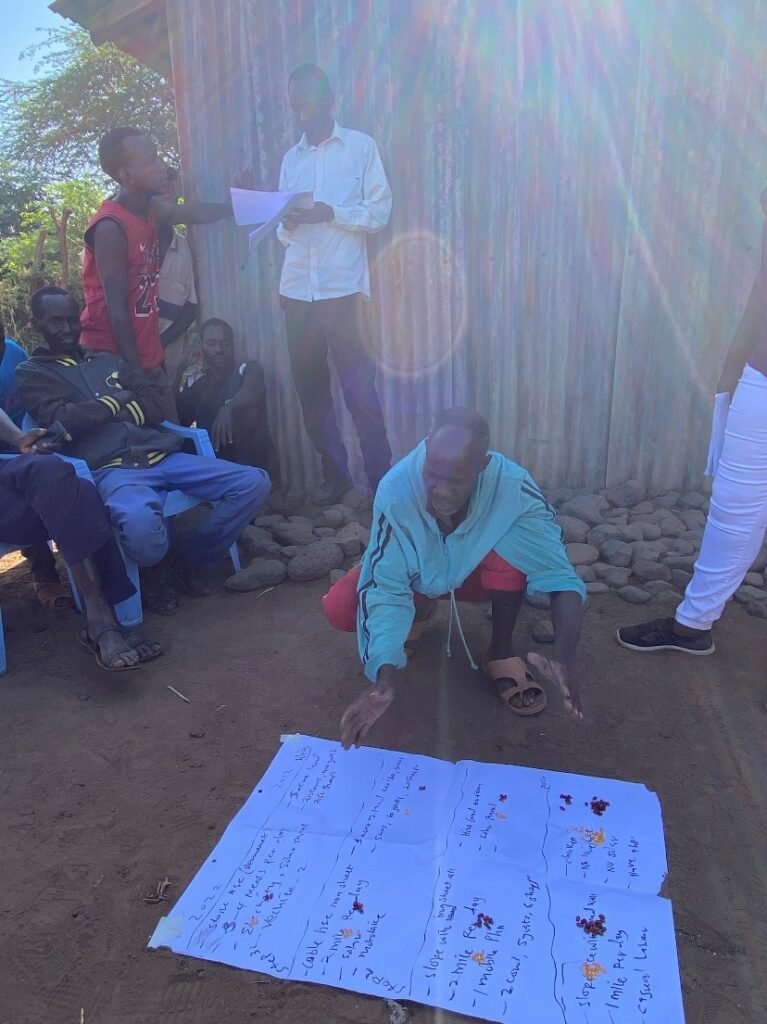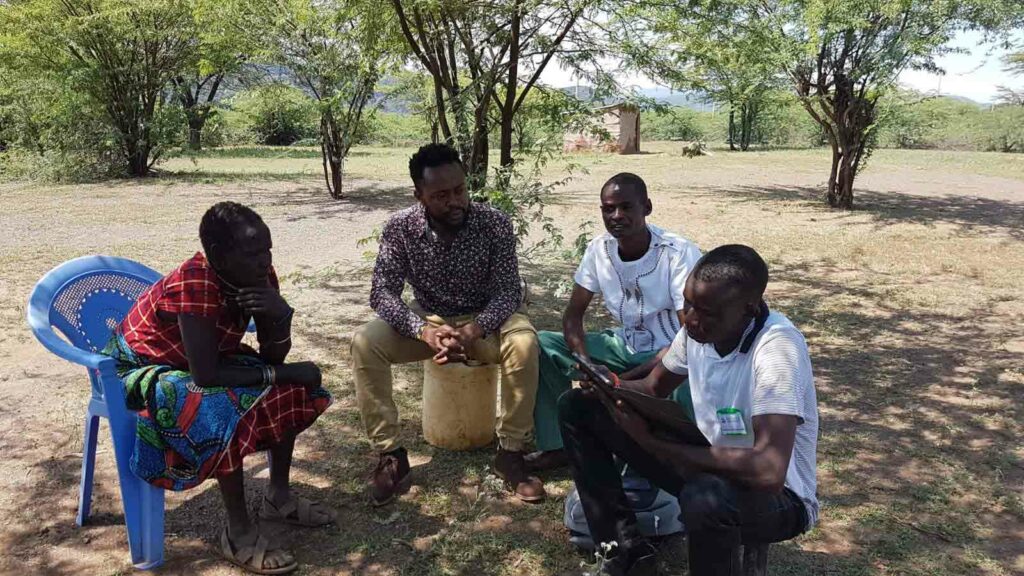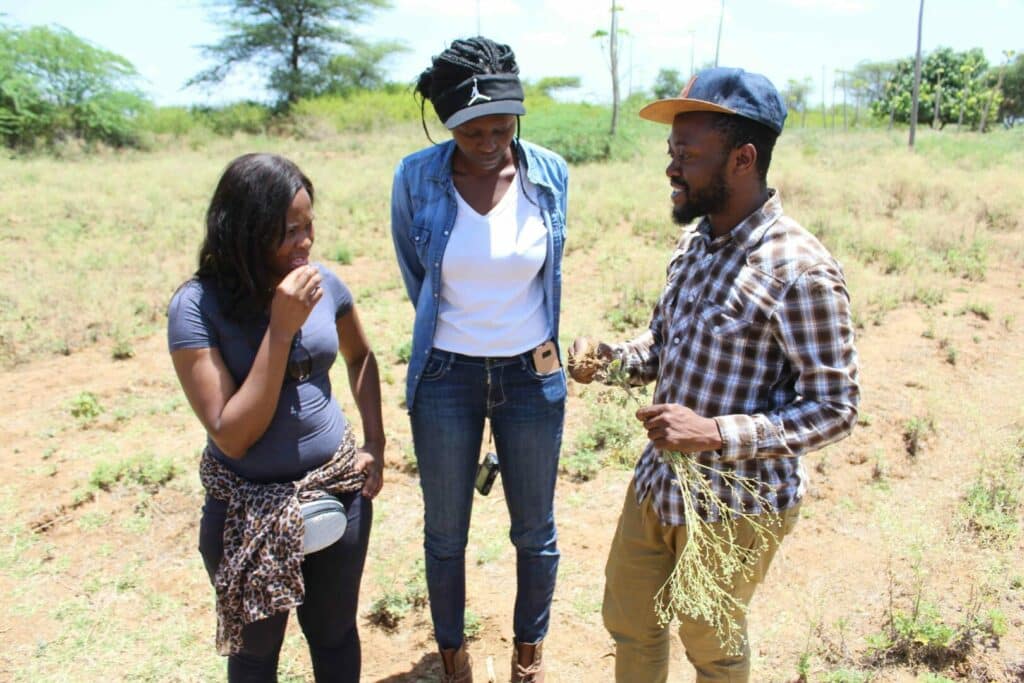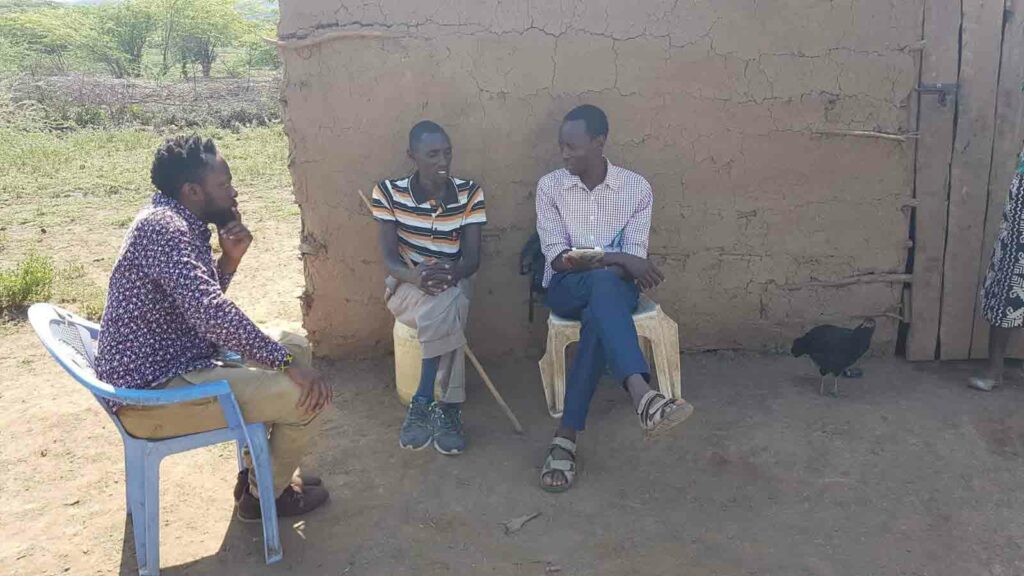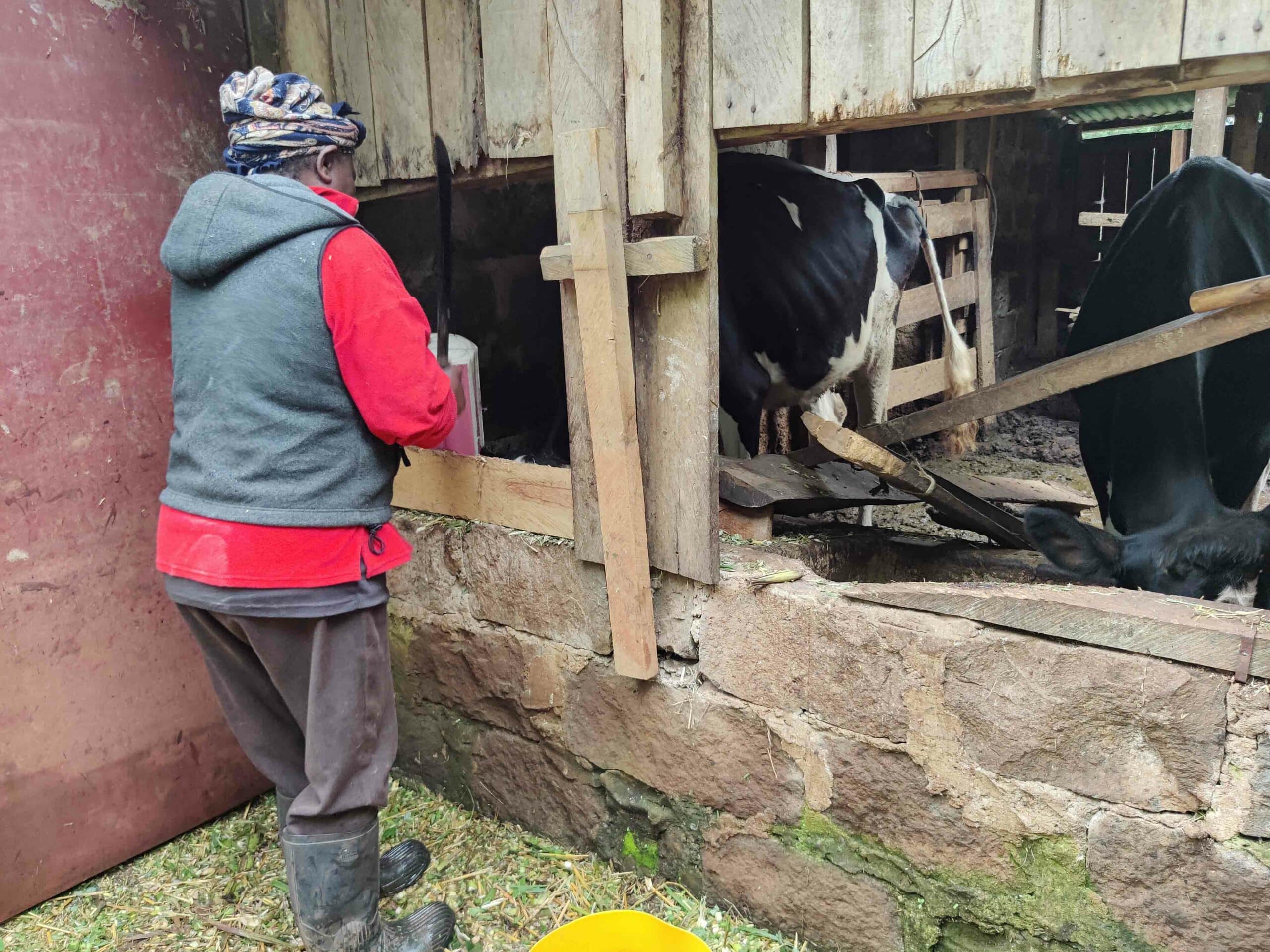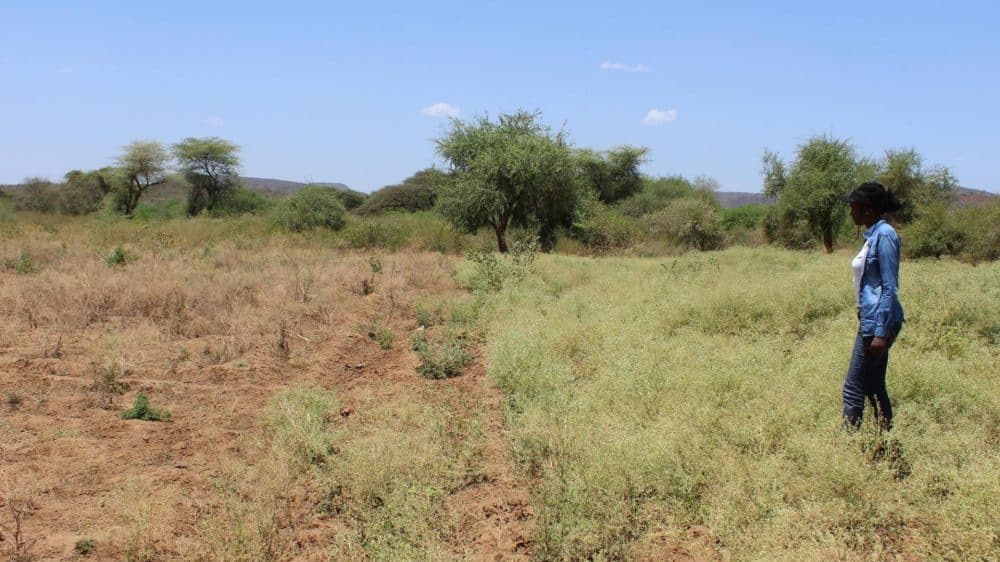CRC TRR 228 Project B01
Invasive Futures
The social ecology of rangelands in changing savanna environments
B01 Invasive Futures
Project Summary
The stewardship of rangelands in Africa is increasingly undermined by overstocking and land degradation, raising the risk of collapse of existing social-ecological rangeland systems. One key driver of rangeland degradation and conversion to other land uses is the undesired spread of alien invasive plant species such as Parthenium hysterophorus and Prosopis juliflora. Invasion has been observed to drastically accelerate in recent years, with land management and environmental conditions shaping the spread dynamics. In addition, factors that drive land-use transition, such as changing people’s aspirations, policies (e.g., the Community Land Act aimed at sedentarizing nomadic pastoralists), and infrastructure developments, may accelerate the spread dynamics. This uncontrolled invasion has affected both the environment and people’s livelihoods, especially those of pastoral households, and their capacities to cope with or respond to future risks and uncertainties. Thus, investigating the factors driving invasion and shaping land uses and rural livelihoods, as well as the effects of invasion and changing aspirations on land productivity, land use, and livelihood transformation, becomes a key element in future-making.
Research of the first two project phases a) identified physical attributes, land use practices, and infrastructure developments driving invasive spread; b) found that invasion in turn affects soil fertility and thus the conditions for agricultural land use; c) showed that exposure to invasive spread and other ecological shocks is associated with lowered aspirations for the future; and d) provided initial evidence that aspirations influence future-oriented investments and livelihood choices, thereby inducing changes in land use and, in turn, feeding back into invasive spread dynamics.
B01 brings together soil scientists, agronomists, and economists to assess and predict future invasive spread and systems’ dynamics, including agrarian and livelihood transitions, in the around lake Baringo, Kenya and beyond. The project examines consequences of plant invasion on soil properties (soil science), land management strategies (agronomy), and individuals’ aspirations, future-oriented investments, and livelihood transformation (economics). It applies multi-disciplinary methods, including household and field surveys, focus group discussions, behavioural-economic experiments, soil sampling, and econometric analyses, resulting in an improved disciplinary and interdisciplinary understanding of the interplay between invasive species spread, agricultural land use and associated livelihood choices.
Research Regions: Lake Baringo Area, Kenya
Problem Statement
Traditional rangeland management and livelihoods in Kenya, and particularly in the Baringo county basin, are slowly changing due to environmental pressures, as well as system-immanent drivers such as rangeland degradation and changing aspirations of land users. Invasive plant species are spreading rapidly, taking over pastoral communal lands and hindering livestock mobility. In response, households are transitioning to arable farming to adapt to the invasion. However, as arable farming expands, the seasonal availability and quality of pasture decrease, further negatively impacting agro-pastoral livelihoods. Furthermore, cropping systems are susceptible to new invasive plant species spread. Ecological shocks such as plant invasions thus become key elements in future-making, as they accelerate social-ecological transitions and livelihood transformative processes in future rangelands.
Key Questions
- What resource attributes and management practices favour the spread of invasive alien plant species?
- How does plant invasion affect the productivity of crop- and rangelands (e.g., crop yields, forage availability and quality) and shape future land-use transitions?
- What economic constraints, risks, and opportunities affect aspirations, and how do aspirations affect systems’ dynamics, including agrarian and livelihood changes, and future-related behaviour (economic mobility)?
- What feedback processes and patterns of transformation from agrarian and livelihood changes emerge upon plant invasion, and how do poverty and aspiration traps constitute barriers to future-making capacities? How do patterns differ across diverse agents (e.g. by gender, class, ethnicity, and other intersectional factors)?
- What is the potential of role models and collective action on plant invasion management?
Methodology
- Analysis of digital elevation models
- Remote sensing
- Geostatistical modelling
- Agronomic field experiments
- Soil property assessments (carbon, nutrients, water dynamics)
- Isotopic analysis to determine origin of soil nutrients
- Crop yield assessments
- Invasive plant species abundance assessment
- Individual, household, and field surveys
- Focus group discussions
- Behavioral-economic experiments
- Econometric analysis of livelihood choices
Outlook for Phase III
The project “Invasive Futures” investigates the role of invasive alien plant species, specifically Prosopis juliflora and Parthenium hysterophorus, in shaping the future of land use and livelihoods in the Baringo area of Kenya. Research during the prior two project phases a)identified physical attributes, land-use practices, and infrastructuring driving the invasive
spread, b) found that invasion in turn affects soil fertility and thereby conditions for agricultural land use, c) showed that exposure of farmers to invasive spread and other ecological shocks goes along with lowered aspirations for the future, and d) provided first evidence that
aspirations affect investments into the future and change livelihood choices, thereby inducing changes in land use, and in turn invasive-spread dynamics. The findings demonstrate the close, dynamic interactions between biophysical and socioeconomic conditions and processes that jointly shape the future of invasive spread and rural
livelihoods. The generated interdisciplinary knowledge allowed the conceptualizing of “phases of invasion”, describing how such interactions and other external drivers lead to dynamic landuse transitions with invasive spread as determinant and result of these transitions. In the third project phase we intend to further our understanding of the dynamic interactions and causal relationships between key processes affecting land-use transitions, specifically related to soil fertility, invasive control, livelihood mobility, and economic and ecological resilience.
Specifically, in the third project phase we will (1) document the dynamic, spatially differentiated invasive spread and associated land-use transitions by a comprehensive mapping and
statistical exercise that will enable comparisons with developments in other invasion-affected regions; (2) analyse how the removal of invasive species will change soil properties, agricultural productivity, and land use, using ecological experiments; (3) investigate how agricultural management practices affect invasion and soil water dynamics based on a survey, a randomized controlled trial, and analyses of soil properties and crop performance; (4) assess how economic resilience of households directly or indirectly depends on invasive-species spread and what role aspirations and externally financed infrastructure play for livelihood choices determining resilience using a three-wave household-panel dataset.
Key Findings from Phase I and II
a) Prosopis spread, soil fertility, and coping strategies: Prosopis has been established in the area since the 1980s. It is mostly found in the seasonally inundated plains, where 65% of households report infestation. Grazed pastures show much higher infestation levels than frequently cropped farmlands. Semi-nomadic pastoralists and agro-pastoralists are more affected by Prosopis infestation than arable farmers. Prosopis stand densities in Baringo County were mapped using ground-truthing and remote sensing, and their relationship with soil fertility was analyzed. Prosopis obtains about 15-20% of its nitrogen from the atmosphere through biological nitrogen fixation and significantly increases carbon (C), nitrogen (N), phosphorus (P), and calcium (Ca) levels in the topsoil.
Economic incentives, such as better market access for hybrid maize, forage seeds, and high-value vegetables, have encourgaed mechanical clearing of Prosopis, driving a shift from pastoralism to crop farming and the development of new livelihood strategies. Other strategies include charcoal production and beekeeping. Data from 530 smallholders show that positive perceptions of Prosopis are linked to charcoal production but negatively associated with beekeeping and eradication efforts; income also increases with charcoal production. A video-based randomized control trial (RCT) with 653 agro-pastoralists demonstrated that showcasing role models enhanced community aspirations and cooperation in Prosopis management, raising willingness to participate in management programs to over 70%, promoting labor exchange, and reducing reliance on paid removal strategies.
b) Parthemium spread and control: Parthenium, likely introduced through wheat seeds from Australia, has rapidly spread across crop- and rangelands over the past five years, negatively impacting crops and animal health. The shift from pastoralism to crop farming, along with mechanized tillage and irrigation, has accelerated the spread of parthenium, especially during fallow periods, which boost the soil seed bank. Dispersal occurs through irrigation canals, road traffic, farm machinery, and manure application. Relatedly, Parthenium is more prevalent in irrigated than in rainfed areas and is influenced by soil and water conditions. Farmers mainly rely on hand weeding, while using herbicides and soil-based control strategies is positively associated with access to extension services, membership in organizations, and the educational level of household heads. However, herbicide use remains largely limited to larger, market-oriented farms.
c) Impact on households and livelihoods: An economic survey collected information on 530 households, including data on farmer and (agro-)pastoralist aspirations in the face of invasive species and related livelihood threats. Households generally aspire beyond their current status regarding income, assets, livestock, and social status. However, ecological shocks such as the widespread invasion of Prosopis and the emerging spread of Parthenium negatively affects these aspirations, particularly those related to income and assets. Similarly relevant for future making, non-cognitive skills such as self-efficacy and locus of control are negatively associated with ecological shocks. Individuals are less likely to believe they have control over life outcomes and tend to judge their capabilities lower when faced with such shocks. Education, access to agricultural extension services, and household wealth are additional determinants of aspiration formation. Cooperative membership contributes positively to the formation of income and asset aspirations. The RCT on community management of Prosopis shows that targeted video interventions signficantly boost aspirations related to community, environment, and social support. Aspirations also shape future-oriented behavior: livestock investments increase with the aspiration gap up to a certain point before declining, indicating aspiration failure. While internal locus of control is positively associated with livestock investment, this relationship weakens as the aspiration gap widens. Additionally, higher aspirations gap is linked to a higher and more sustained livelihood diversification, particularly among the poorest and smallholder households. However, excessively high aspirations relative to current status reverse this effect, particularly among women-headed households, providing evidence of gendered aspirations failure
d) Response strategies and land-use patterns: Coping with risks and uncertainties entails changes in livelihood strategies and shifts in production systems. Observations indicate that practices of future-making appear to be dominated by shifts from pastoral land use towards agro-pastoralism or even intensive crop farming and non-farm livelihoods. However, the extent of these livelihood shifts appears to depend on resource endowments and access to physical, social, and educational infrastructure, with better-off actors acting as pacemakers. Male-headed households are observed to engage more and sustain their engagement in diversified livelihoods, specifically intensive crop farming and agro-pastoralism with larger livestock, while a substantial number of female-headed households (mainly widows) remain in single livelihoods, such as small-scale livestock raising and forest-based activities including charcoal and honey production. Differences in aspirations, with women tending to have lower absolute aspirations, are associated with these different livelihood transitions. While women may aspire to shift to invasion-adaptive livelihood strategies, they are unable to translate their aspirations into actions due to their poor endowments.
Relation to the CRC
The integrated agro-economic project on invasive futures is closely linked to several CRC projects. In collaboration with Z03, the project contributed to the further development of CRC 228’s large, cross-country panel household survey and supported data collection in Kenya. A joint publication with C08 was prepared on the impact of aspirations on income diversification, utilizing the Z03 two-wave panel dataset. Additionally, the project collaborated with A02, A04, A05, and C02 in organizing and contributing to a stakeholder and project partner workshop held in September 2024 in Baringo County, Kenya. This workshop fostered dialogue on environmental conservation and socio-economic transformations in the region. During the event, the project presented findings from the first and second phases, focusing on aspirations, livelihood changes, gendered livelihoods and perceptions of invasion, and the drivers and pathways of land-use transitions in Baringo County. Furthermore, collaboration with A05 included research on the spread of Prosopis, the development of soil moisture maps in Baringo County, and analyses of land use transitions in Kenya, Tanzania, and Namibia.
In Progress
Publications:
- Bacud, E.S.T., Heckelei, T., & Ihli, H.J. ‘Beyond capital assets: Evidence of gendered aspirations failure in rural livelihood diversification’ (under review).
- Becker, M., Biber-Freudenberger, L., Börner, J., & Heckelei, T. ‘Land system transitions in rural Africa: Validating the middle-range theory of change’ (submitted).
- Ihli, H.J., Rommel, J, Bacud, E.S.T., Baylis, K., & Heckelei, T. ‘Community aspirations and voluntary provision of public goods: Evidence on cooperative management of invasive species in Kenya’ (under review).
- Mutuku, D.M., Becker, B., Behn, K., & Kamiri, H. ‘The role of Parthenium invasion on agricultural land use change in the Njemp Flats: A change detection analysis’.
- Sainepo, M.B., Behn, K., and Becker, M. (2024). Contextualizing Parthenium abundance with hydro-edaphic conditions and native plant species in different land systems in Baringo, Kenya. Biological Invasions. DOI (pre print)
Master's Theses:
- Akindipe, A. Aspirations and Agricultural Investments: Insights from a Two-Wave Panel Study in Rural Kenya. Master thesis (ongoing), University of Bonn, Germany
- Asiyo, S.P. Impacts of invasive weed Parthenium hysterophorus (Asteraceae) on native plant diversity in Baringo lowlands, Kenya. Master thesis (ongoing), Karatina University, Kenya
- Issaka, F.C. Land Tenure’s Influence on Invasive Species Control Strategies in Kenya. Master thesis (ongoing), University of Bonn, Germany
- Momanyi, E.R. Effects of Invasive Weed Parthenium hysterophorus on Growth of Selected Field Crops and Pasture Grass in the Njemps Flats, Baringo County, Kenya. Master thesis (ongoing), Karatina University, Kenya
Accomplishments
Publications
Agha, SB., Alvarez, M., Becker, M., Fèvre, EM., Junglen, S., Borgemeister C 2021. ‘Invasive alien plants in Africa and the potential emergence of mosquito-borne arboviral diseases—A review and research outlook‘. Viruses vol.13, pp. 32. DOI
Alvarez, M., Curran, M. & Malombe, I. 2021. SWEA-Dataveg: A vegetation database for sub-Saharan Africa. Vegetation Classification and Survey. DOI
Alvarez, M., Heller, G., Malombe, I., Matheka, KW, Choge, S. & Becker, M. 2019. ‘Classification of Prosopis juliflora invasion in the Lake Baringo basin and environmental correlations’. African Journal of Ecology vol. 57(3), pp. 296-303. DOI
Bacud, E.S.T., Gerullis M.K., Puskur R., Heckelei, T. 2024. ‘Looking at gender is not enough—How diversity of farmer’s marginalization relates to variety preferences’. Food Policy, 124. DOI
Becker, M., Behn, K., Heller, G., & Kamiri, H.W. 2025. ‘Is soil fertility the cause or the effect of land invasion by Prosopis?’ Journal of Plant Nutrition and Soil Science, Early View. DOI
Kamiri, H., Choge, S., & Becker, M. 2024. ‘Management strategies of Prosopis juliflora in eastern Africa. What works where?’ Diversity, 16(4), 251. DOI
Tabe-Ojong, M.P. 2023. ‘Action against invasive species: Charcoal production, beekeeping, and Prosopis eradication in Kenya’. Ecological Economics. 203, 107614. DOI
Tabe-Ojong, M.P. 2022. ‘Ecological shocks and non-cognitive skills: Evidence from Kenya’, Ecological Economics, vol. 194, no. 107330 DOI
Tabe-Ojong, M.P., Alvarez, M., Ihli, H., Becker, M., & Heckelei, T. 2021. ‘Action on Invasive Species: Control Strategies of Parthenium hysterophorus L. on Smallholder Farms in Kenya’, Environmental Management. DOI
Tabe-Ojong, M.P., Gebrekidan, B.H., Nshakira-Rukundo, E., Börner, J., & Heckelei, T. 2022. ‘COVID-19 in rural Africa: Food access disruptions, food insecurity and coping strategies in Kenya, Namibia, and Tanzania‘, Agricultural Economics, pp. 1– 20. DOI.
Tabe-Ojong, M.P., Hauser, M., Mausch, K. 2022. ‘Does Agricultural Commercialisation Increase Asset and Livestock Accumulation on Smallholder Farms in Ethiopia?‘, The Journal of Development Studies. DOI
Tabe-Ojong, M.P., Heckelei, T. & Baylis, K. 2021. ‘Aspiration formation and ecological shocks in Rural Kenya. The European Journal of Development Research. (Online First Articles). Link
Tabe-Ojong, M. P., Heckelei, T., Baylis, K., Rasch, S. 2023. Cooperative membership and exposure to role models: Implications for income and asset aspirations, Journal of Behavioral and Experimental Economics, Volume 107, 2023, DOI
Tabe-Ojong, M.P., Heckelei, T., Rasch, S. 2022. Aspirations and investments in livestock: Evidenceof aspiration failure in Kenya, The Journal of the International Association of Agricultural Economics. Full Text
Tabe-Ojong, M.P., Kedinga, M.E. & Gebrekidan, B.H. 2024. Behavioural factors matter for the adoption of climate-smart agriculture. Sci Rep 14, 798 (2024). DOI
Tabe-Ojong, M.P., Mausch, K., Woldeyohanes, T., Heckelei, T. 2021. ‘Three hurdles towards commercialization: Integrating subsistence chickpea producers in the market economy’. European Review of Agricultural Economics. DOI
Tabe-Ojong, M.P. & Nshakira-Rukundo, E. 2021. ‘Religiosity and parental educational aspirations for children in Kenya,’ World Development Perspectives, Volume 23, 100349. DOI
Master's & Bachelor's Engagements
Ahor, R.K. 2025. Aspirations and Agricultural Investments in Rural Tanzania. Master thesis, University of Bonn, Germany
Gardner, E. 2022. Forest Incomes: A Means to Achieve Aspirations and Move Out of Poverty? Master thesis, University of Bonn, Germany and UCLouvain, Belgium. Summary
Gardner, E. Forest Incomes: A Means to Achieve Aspirations and Move Out of Poverty? (2022 November). Summary
Kalu, N.O. 2024. Gendered Perceptions of Prosopis juliflora and Preferences for Management Strategies: A Case Study of Baringo Region, Kenya. Master thesis, University of Bonn, Germany
Momanyi, E. Resource Competition of Invasive Weed Parthenium hysterophorus on Selected Field and Pasture crops in the Njemps flats, Baringo County.
Ndikumwenayo, M. 2024. Recent Changes in Cropping Practices in the Face of Invasive Plant Species in Baringo, Kenya. Master thesis, University of Bonn, Germany
Ndikumwenayo, M. Recent changes in cropping practices in the face of invasive plant species in Baringo, Kenya (March, 2024)
Conferences & Working Papers
Conference contributions / Working papers
Alvarez, M., Kiboi, S., Becker, M., & Malombe, I. 2019. ‘Modelling potential dispersal of Prosopis juliflora in East Africa: Scaling and assembling correlations‘. 15th International Conference on Ecology and Management of Alien Plant invasions (EMAPi): Integrating research, management and policy, September 9-13, 2019, Prague, Czech Republic. Access Link
Bacud, E.S.T., Heckelei, T., & Ihli, H. 2024. ‘The unknown link between aspirations and livelihoods: Do aspirations explain gendered livelihood diversification?’ International Association of Agricultural Economists (IAAE) 2024 Conference, August 2-7, 2024, New Delhi, India. Access Link
Behn, K., Kamiri, H.W., Mutuku, D.M., Ndikumwenayo, M., Sainepo, B.M., & Becker, M. 2024. ‘Invasive plant species drive land use changes in East Africa’. Tropentag 2024. International Research on Food Security, Natural Resource Management and Rural Development. Explore opportunities…for managing natural resources and a better life for all, September 11-13, 2024, Vienna, Austria. Access Link
Guthoff, J., Mutsami, C., Parlasca, M., Heckelei, T., & Qaim, M. 2024. ‘Aspirations and livelihood diversification in rural Africa’. ZEF Discussion Papers on Development Policy 357. Access Link
Ihli, H.J., Rommel, J., Bacud, E.S.T, Baylis, K.R., & Heckelei, T. 2025. ‘Community aspirations and voluntary provision of public goods: Evidence on cooperative management of invasive species in Kenya’. Access Link (pre print)
Mutuku, D.M., Kamiri H.W., Behn, K., & Becker, M. 2024. ‚Soil moisture dynamics determine abundance of invasive Parthenium hysterophorus in Baringo, Kenya’. First Joint International Scientific Conference: Utilisation of Biological Resources for Sustainable Development, Nature Conservation and Climate Resilience. National Museums of Kenya, Nairobi, Kenya. Oral Presentation.
Sainepo, B., Alvarez, M., & Becker, M. 2021. ‘Impact of Parthenium hysterophorus invasion on plant species composition and soil properties in grassland communities in the Njemps flats, Kenya’. Joint International Grassland & International Rangeland Kenya 2021 Virtual Congress, October 25-29.
Sainepo, B., Tabe-Ojong, M.P., Kiboi, S., Malombe, I., Becker, M., Heckelei, T., & Alvarez, M. 2019. Parthenium hysterophorus in East Africa: A numerical review’. 15th International Conference on Ecology and Management of Alien Plant invasions (EMAPi): Integrating research, management and policy, September 9-13, 2019, Prague, Czech Republic. Access Link
Tabe-Ojong, M.P., Heckelei, T., & Baylis, K. 2020. ‘Aspiration formation and ecological shocks: An exploratory analysis in rural Kenya‘. Paper presented at the Annual Meeting of the American Applied Economics Association (AAEA), July 26-28, Kansas City, US. Access Link
Tabe-Ojong, M.P., Heckelei, T. & Baylis, K. 2020. ‘Collective action and smallholder rural households: Implications for income and asset aspirations‘ Paper presented at the Annual Meeting of the American Applied Economics Association (AAEA), July 26-28, Kansas City, US. Access Link

